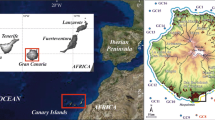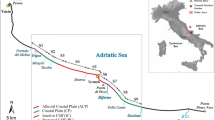Abstract
This research aims to evaluate and compare the historical morphodynamic behaviour of coastal systems (shoreline dynamics) in Southwest England in response to the historical meteorological and oceanographic (metocean) attributes. Historical geomorphological evolution of the two shoreline systems in St Ives-Hayle and Camel-Padstow were examined to evaluate morphodynamic activities through the application of shoreline analysis tools (such as Digital Shoreline Analysis System - DSAS), while the broad metocean features were investigated as the possible drivers of coastal dynamics. This study showed that low shoreline recession along southwest England coast, where sediments are present, was attributed mostly to the significant sea-level rise in this region (no significant change was observed on rocky low water shorelines). The high water shoreline, on the other hand, imposes a different pattern of change in response to constraining factors, as different percentages of erosion and accretion are observed at different sections of the study sites, principally triggered by both environmental factors and anthropogenic activities. The general overview of the regional control suggests that climatic activities (specifically wave climate and extreme wind) variably account for the persistent and progressive gradual erosion of some shorelines amidst evidence of cyclic/variable behaviour. No one specific metocean forcing, however, exerts an overarching control on these systems, but the nature of the shoreline (sedimentary vs. bedrock) is responsible for local variability.










Similar content being viewed by others
References
Al Bakri D (1996) A geomorphological approach to sustainable planning and management of the coastal zone of Kuwait. Geomorphology 17:323–337
Albert P, Jorge G (1998) Coastal changes in the Ebro delta: natural and human factors. J Coast Conserv 4:17–26
Allen JRL (2004) Annual textural bending in Holocene estuarine silts, Severn Estuary Levels (SW Britain): patterns, cause and implications. The Holocene 14(4):536–552
Anders FJ, Byrnes MR (1991) Accuracy of shoreline change rates as determined from maps and aerial photographs. Shore Beach 59:17–26
Bitner-Gregersen EM, Ewans KC, Johnson MC (2014) Some uncertainties associated with wind and wave description and their importance for engineering applications. Ocean Eng. doi:10.1016/j.oceaneng.2014.05.002i
Blott SJ, Pye K, van der Wal D, Neal A (2006) Long-term morphological change and its causes in the Mersey Estuary, NW England. Geomorphology 81:185–206
Brew DS, Gibberd BB (2009) Geomorphological change and its impact on habitats in the Camel Estuary, Cornwall, UK. Geosci South-West England 12:95–100
Burningham H, French J (2012) Is the NAO winter index a reliable proxy for wind climate and storminess in northwest Europe? Int J Climatol. doi:10.1002/joc.3571
Buscombe DD, Scott, T.M (2008) The Coastal Geomorphology of North Cornwall: St Ives Head to Trevose Head. Wave hub Impact on Seabed and Shoreline Processes (WHISSP). University of Plymouth
Clarke ML, Rendell HM (2009) The impact of North Atlantic storminess on western European coasts: a review. Quat Int 95(1–2):31–41
Crowel M, Leatherman SP, Buckley MK (1991) Historical shoreline change-error analysis and mapping accuracy. J Coast Res 7:839–852
DEFRA/EA (2004) Integrated Research Results on Hydrobiosedimentary Processes in Estuaries., DEFRA/Environment Agency Flood and Coastal Defence R &D Programme
Draper L (1991) Wave climate Atlas of the British Isles. London
Hansom JD (2001) Coastal sensitivity to environmental change: a view from the beach. Catena 42:291–305
López-Ruiz A (2014) A note on alongshore sediment transport on weakly curvilinear coasts and its implications. Coast Eng 88:143
Maiti S, Bhattacharya AK (2009) Shoreline change analysis and its application to prediction: a remote sensing and statistics based approach. Mar Geol 257:11–23
Mason SJ, Hansom JD (1988) Cliff erosion and its contribution to a sediment budget for part of the Holderness coast, England. Shore Beach 56(4):30–38
Milligan DA, O’Brien KP, Wilcox CS, Hardaway JR (2010a) Shoreline evolution: City of Newport News, Virginia James River and Hampton Roads Shorelines. Virginia Institute of Marine Science, College of William & Mary, Gloucester Point
Milligan DA, O’Brien KP, Wilcox CS, Hardaway JR (2010b) Shoreline evolution: city of Poquoson, Virginia, Poquoson River, Chesapeake Bay, and back river shorelines. Virginia Institute of Marine Science, College of William & Mary, Gloucester Point
Montreuil AL, Bullard JE (2012) A 150-year record of coastline dynamics within a sediment cell: Eastern England. Geomorphology 179:168–185
Moore LJ (2000) Shoreline mapping techniques. J Coast Res 16:111–124
Nebel SH, Trembanis AC, Barber DC (2012) Shoreline analysis and barrier island dynamics: decadal scale patterns from Cedar Island, Virginia. J Coast Res 28(2):332–341
NERC (1998) United Kingdom Digital Marine Atlas, BODC UK Natural Environment Research Council. Birkenhead, Merseyside
Noall C (1984) The book of Hayle Buckingham. Barracuda Books Ltd, England
Oyedotun TDT (2014) Section 3.2.2. shoreline geometry: DSAS as a tool for historical trend analysis. In: Clarke, L. and Nield, J. M. (Eds) Geomorphological Techniques (Online Edition). British Society for Geomorphology; London: UK. ISSN: 2047 – 0371 (http://geomorphology.org.uk/assets/publications/subsections/pdfs/OnsitePublicationSubsection/42/3.2.2_shorelinegeometry.pdf)
Oyedotun TDT, Burningham H, French JR (2012) Characterisation of estuary and adjacent beach sediments in the Gannel Estuary, south-west England. Geosci South-west England 13:70–76
Oyedotun TDT, Burningham H, French JR (2013) Sediment sorting and mixing in the Camel Estuary, UK. In: Conley, D. C., Masserlink, G., Russell, P. E. and O’Hare, T. J. (Eds), Proceedings 12th International Coastal Symposium (Plymouth, England), Journal of Coastal Research, Special Issue No 65, pp. 1563–1568, ISSN 0749-0208. DOI: 10.2112/S165-264.1
Pascoe H (2005) The book of Hayle: portrait of a Cornish coastal town. Halsgrove, Devon
Phillips MR, Rees EF, Thomas T (2013) Winds, sea levels and North Atlantic Oscillation (NAO) influences: an evaluation. Glob Planet Chang 100:145–152
Pirrie D, Beer AJ, Camm GS (1999) Early diagenetic sulphide minerals in the Hayle Estuary, Cornwall. Geosci South-West England 9:325–332
Pirrie D, Power MR, Payne GS, Wheeler PD (2000) Impact of mining on sedimentation: the Camel and Gannel estuaries, Cornwall. Geosci South-West England 10:021–028
PSMSL (2013) Newlyn tide gauge data. [http://www.psmsl.org/data/obtaining/stations/202.php]
Pye K, Blott SJ (2014) The geomorphology of UK estuaries: the role of geological controls, antecedent conditions and human activities. Estuar Coast Shelf Sci 150:196–214
Pye K, Neal A (1994) Coastal dune erosion at Formby Point, North Merseyside, England – causes and mechanisms. Mar Geol 119:39–56
Saye SE, van der Wal D, Pye K, Blott SJ (2005) Beach-dune morphological relationships and erosion/accretion: an investigation at five sites in England and Wales using LIDAR data. Geomorphology 72:128–155
Scott T, Russell P, Masselink G, Wooler A, Short A (2007) Beach rescue statistics and their relation to nearshore morphology and hazards: a case study for southwest England. Journal of Coastal Research, SI 50 (Proceedings of the 9th International Coastal Symposium), 1 – 6. Gold Coast, Australia, ISSN 0749.0208
Sherman DJ, Bauer BO (1993) Coastal geomorphology through the looking glass. Geomorphology 7:225–249
SWRDA - South West of England Development Agency (2006) Wave Hub development and design phase, SWRDA Group Limited, coastal processes study report. http://www.wavehub.co.uk/
Taylor JA, Murdock AP, Pontee NI (2004) A macroscale analysis of coastal steepening around the coast of England and Wales. Geogr J 170(3):179–188
Thieler ER, Danforth WW (1994a) Historical shoreline mapping (1) improving techniques and reducing positioning errors. J Coast Res 10:549–563
Thieler ER, Danforth WW (1994b) Historical shoreline mapping (II) Application of the Digital Shoreline Mapping and Analysis Systems (DSMS/DSAS) to shoreline change mapping in Puerto Rico. J Coast Res 10(3):600–620
Thieler ER, Himmelstoss EA, Zichichi JL, Ergul A (2009) The Digital Shoreline Analysis System (DSAS) Version 4.0 - An ArcGIS Extension for Calculating Shoreline Change. Open-File Report. US Geological Survey Report No. 2008-1278
Thiruventakasamy K, Girija DKB (2014) Shoreline evolution due to construction of rubble mound jetties at Munambam inlet in Ernakulam-Trichur district of the state of Kerala in the Indian peninsula. Ocean Coast Manag 102:234–247
Tsoukala VK, Katsardi V, Hadjibiros K, Moutzouris CI (2015) Beach erosion and consequential impacts due to the presence of harbours in sandy beaches in Greece and Cyprus. Environ Process 2:S55–S71
Uncles RJ, Stephen JA, Harris C (2015) Estuaries of southwest England: salinity, suspended particulate matter, loss-on-ignition and morphology. Prog Oceanogr 137:385–408
Zuzek PJ, Nairn RB, Thieme SJ (2003) Spatial and temporal consideration for calculating shoreline change rates in the Great Lakes Basin. J Coast Res 38:125–146
Acknowledgments
This work was undertaken as part of my research doctorate programme at the Coastal and Estuarine Research Unit, Department of Geography, University College London. The author appreciates the supervisory assistantship of Dr Helene Burningham and Prof Jon French during the PhD programme. The author also appreciates the anonymous reviewers for their valuable comments and suggestions.
Author information
Authors and Affiliations
Corresponding author
Rights and permissions
About this article
Cite this article
Oyedotun, T.D.T. Shoreline Evolution and Metocean Data Behaviour in Southwest England: Is There Any Historical Link?. Environ. Process. 3, 939–960 (2016). https://doi.org/10.1007/s40710-016-0189-4
Received:
Accepted:
Published:
Issue Date:
DOI: https://doi.org/10.1007/s40710-016-0189-4




